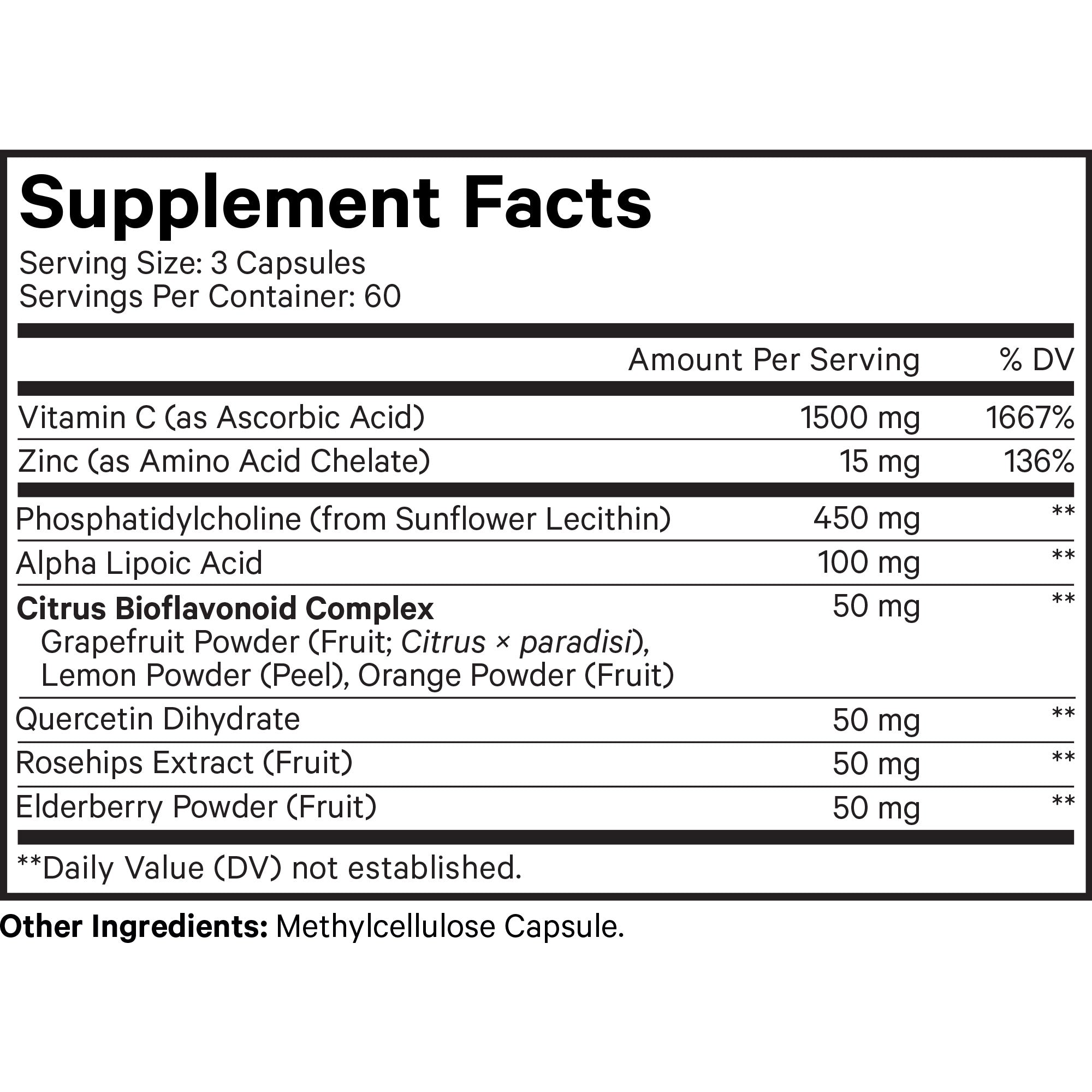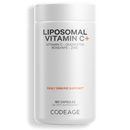- Codeage Vitamina C Liposomal+ contiene una dosis alta de 1500 mg de vitamina C por porción y un complejo de bioflavonoides cítricos hecho de pomelo, limón y naranja en polvo. Cada botella viene con 2 meses de suministro.
- Este suplemento en cápsulas de vitamina C ofrece quercetina, baya de saúco y extracto de rosa mosqueta para brindar una combinación integral de nutrientes. Este suplemento de vitamina C de 1500 mg también viene con 15 mg de mineral de zinc por porción y ácido alfa lipoico.
- Este suplemento de vitamina C como ácido ascórbico viene con 15 mg de mineral de zinc por porción y ácido alfa lipoico para elevar aún más esta fórmula de vitamina C.
- Este suplemento de vitamina C de 1500 mg presenta una administración liposomal que utiliza fosfatidilcolina de girasol sin OGM.
- Codeage Vitamina C Liposomal+ es vegano, no contiene OGM, lácteos, gluten ni soja. Esta fórmula de vitamina C de 1500 mg se fabrica en los Estados Unidos en una instalación certificada por cGMP por su calidad y pureza. También está disponible en sobres una fórmula líquida liposomal de vitamina C de 1000 mg , lo que facilita su incorporación a su rutina diaria.
Liposomal Vitamin C+
- Codeage Vitamina C Liposomal+ contiene una dosis alta de 1500 mg de vitamina C por porción y un complejo de bioflavonoides cítricos hecho de pomelo, limón y naranja en polvo. Cada botella viene con 2 meses de suministro.
- Este suplemento en cápsulas de vitamina C ofrece quercetina, baya de saúco y extracto de rosa mosqueta para brindar una combinación integral de nutrientes. Este suplemento de vitamina C de 1500 mg también viene con 15 mg de mineral de zinc por porción y ácido alfa lipoico.
- Este suplemento de vitamina C como ácido ascórbico viene con 15 mg de mineral de zinc por porción y ácido alfa lipoico para elevar aún más esta fórmula de vitamina C.
- Este suplemento de vitamina C de 1500 mg presenta una administración liposomal que utiliza fosfatidilcolina de girasol sin OGM.
- Codeage Vitamina C Liposomal+ es vegano, no contiene OGM, lácteos, gluten ni soja. Esta fórmula de vitamina C de 1500 mg se fabrica en los Estados Unidos en una instalación certificada por cGMP por su calidad y pureza. También está disponible en sobres una fórmula líquida liposomal de vitamina C de 1000 mg , lo que facilita su incorporación a su rutina diaria.
Artículo similar a considerar

Women's Daily Multivitamin+
$34.99Información nutricional

Ingredientes
Vitamina C (como ácido ascórbico), zinc (como quelato de aminoácidos), fosfatidilcolina (de lecitina de girasol), ácido alfa lipoico, complejo de bioflavonoides cítricos: pomelo en polvo (fruta), limón en polvo (cáscara), naranja en polvo (fruta), quercetina Dihidrato, Extracto de Rosa Mosqueta (Fruta), Saúco en Polvo (Fruta). Otros ingredientes: Cápsula de metilcelulosa.
Artículo similar a considerar

Women's Daily Multivitamin+
$34.99EXPLORA MÁS.
PRODUCTO GALERÍA.





Product Details
Supplement Facts

Ingredients
Vitamina C (como ácido ascórbico), zinc (como quelato de aminoácidos), fosfatidilcolina (de lecitina de girasol), ácido alfa lipoico, complejo de bioflavonoides cítricos: pomelo en polvo (fruta), limón en polvo (cáscara), naranja en polvo (fruta), quercetina Dihidrato, Extracto de Rosa Mosqueta (Fruta), Saúco en Polvo (Fruta). Otros ingredientes: Cápsula de metilcelulosa.
Suggested Use
Tome 3 cápsulas al día con 8 onzas de agua o su bebida favorita. Puede tomarse con o sin alimentos.
PRECAUCIÓN: No exceda la dosis recomendada. Tenga cuidado si tiene alergias o sensibilidades a alguno de los ingredientes enumerados. Las madres embarazadas o lactantes y las personas con una afección médica conocida deben consultar a un médico antes de usar este o cualquier suplemento dietético. Utilizar sólo según las indicaciones. Si experimenta molestias gastrointestinales (incluyendo hinchazón, calambres, diarrea u otros trastornos digestivos) u otra sensibilidad, deje de tomar el producto inmediatamente. Si está embarazada, amamantando o tiene una condición médica, consulte con su médico antes de usarlo. Si tiene alguna pregunta sobre el consumo de este suplemento dietético, consulte con su profesional de la salud antes de usarlo. Si usa medicamentos recetados o de venta libre, desconoce su condición médica actual o tiene una condición médica preexistente, consulte con su profesional de la salud antes de usarlos. Suspenda su uso inmediatamente si experimenta algún síntoma o reacción adversa mientras toma este producto. Suspenda su uso 2 semanas antes de la cirugía. No lo use si se desconoce su estado de salud. No lo utilice si el sello de seguridad está dañado o falta. Mantener fuera del alcance de los niños y las mascotas. Conservar en un lugar fresco y seco, alejado de la humedad del calor. Utilice este producto únicamente como complemento alimenticio. No utilice para la reducción de peso.
EXPLORA MÁS.

Vitamina C mejorado.
Descubra la moderna mezcla de Codeage Liposomal Vitamin C+, elaborada meticulosamente con vitamina C, zinc, quercetina y una mezcla de saúco y escaramujos.

BAYA DE SAÚCO Y ROSA MOSQUETA.

QUERCETINA Y ZINC.

USO SUGERIDO.
Tome 3 cápsulas al día con 8 onzas de agua o su bebida favorita. Puede tomarse con o sin alimentos.
PRECAUCIÓN: No exceda la dosis recomendada. Tenga cuidado si tiene alergias o sensibilidades a alguno de los ingredientes enumerados. Las madres embarazadas o lactantes y las personas con una afección médica conocida deben consultar a un médico antes de usar este o cualquier suplemento dietético. Utilizar sólo según las indicaciones. Si experimenta molestias gastrointestinales (incluyendo hinchazón, calambres, diarrea u otros trastornos digestivos) u otra sensibilidad, deje de tomar el producto inmediatamente. Si está embarazada, amamantando o tiene una condición médica, consulte con su médico antes de usarlo. Si tiene alguna pregunta sobre el consumo de este suplemento dietético, consulte con su profesional de la salud antes de usarlo. Si usa medicamentos recetados o de venta libre, desconoce su condición médica actual o tiene una condición médica preexistente, consulte con su profesional de la salud antes de usarlos. Suspenda su uso inmediatamente si experimenta algún síntoma o reacción adversa mientras toma este producto. Suspenda su uso 2 semanas antes de la cirugía. No lo use si se desconoce su estado de salud. No lo utilice si el sello de seguridad está dañado o falta. Mantener fuera del alcance de los niños y las mascotas. Conservar en un lugar fresco y seco, alejado de la humedad del calor. Utilice este producto únicamente como complemento alimenticio. No utilice para la reducción de peso.




















































































































